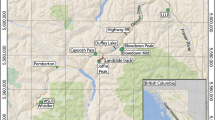Abstract
The Todagin Creek landslide is located at 57.61° N 129.98° W in Northwest British Columbia. A seismic station 90 km north of the landslide recorded the event at 1643 hours coordinated universal time (UTC; 0943 hours Pacific daylight time (PDT)) on October 3, 2006. The signal verifies the discovery and relative time bounds provided by a hunting party in the valley. The landslide initiated as a translational rock slide on sedimentary rock dipping down slope at 34° and striking parallel to the valley. The landslide transformed into a debris avalanche and had a total volume estimated at 4 Mm3. An elevation drop of 771 m along a planar length of 1,885 m resulted in a travel angle (fahrböschung) of 21.3°. The narrowest part of the landslide through the transport zone is 345 m. The widest part of the divergent toe of the landslide reaches a width of 1,010 m. Landslide debris impounded a lake of approximately 32 ha and destroyed an additional 67 ha of forest. The impoundment took 7 to 10 days to fill, with muddied waters observed downstream on October 13. No clear linkage exists with precipitation and temperature records preceding the landslide, but strong diurnal temperature cycles occurred in the days prior to the event. The Todagin Creek area appears to have an affinity for large landslides with the deposits of three other landslides >5 Mm3 observed in the valley.













Similar content being viewed by others
References
Blais-Stevens A, Geertsema M, Schwab JW, Asch Th van, Egginton VN (2007) The 2005 Sutherland River rock slide – debris avalanche, central British Columbia. 1st Int Landslide Conf, Vail, Colorado, USA.
Bottino GM, Chiarle M, Joly A, Mortara G (2002) Modelling rock avalanches and their relation to permafrost degradation in glacial environments. Permafr Periglac Process 13:283–288
Cruden DM, Varnes DJ (1996) Landslide types and processes. In: Turner AK, Shuster RL (eds) Landslides investigation and mitigation, Special Report 247. Transportation Res Board Natl Res Counc, Washington DC, pp 36–75
Deparis J, Jongmans D, Cotton F, Baillet L, Thouvenot F, Hantz D (2008) Analysis of rock-fall and rock-fall avalanche seismograms in the French Alps. Bull Seismol Soc of Am 98:1781–1796
Duffel S, Souther JG (1964) Geology of the Terrace map-area, British Columbia (103 I E 1/2). Geol Surv of Can Memoir 329.
Geertsema M, Cruden DM (2008) Travels in the Canadian Cordillera. 4th Cdn Conf on Geohazards. Quebec, PQ. p. 383–390
Geertsema M, Clague JJ, Schwab JW, Evans SG (2006a) An overview of recent large catastrophic landslides in northern British Columbia, Canada. Eng Geol 83:120–143
Geertsema M, Hungr O, Schwab JW, Evans SG (2006b) A large rockslide-debris avalanche in cohesive soil at Pink Mountain, northeastern British Columbia, Canada. Eng Geol 83:64–75
Geertsema M, Egginton VN, Schwab JW, Clague JJ (2007) Landslides and historic climate in northern British Columbia. Landslides and Climate Change – Challenges and Solutions. In McInnes R, Jakeways J, Fairbank H, Mathie E (eds) Taylor and Francis, UK, p. 9–16
Glastonbury J, Fell R (2010) Geotechnical characteristics of large rapid rock slides. Can Geotech J 47:116–132
Gruber S, Haeberli W (2007) Permafrost in steep bedrock slopes and its temperature-related destabilization following climate change. J Geophys Res 112:F02S18. doi:10.1029/2006JF000547
Haeberli W, Hallet B, Arenson L, Elconin R, Humlum O, Kääb A, Kaufmann V, Ladanyi B, Matsuoka N, Springman S, Vonder Mühll D (2006) Permafrost creep and rock glacier dynamics. Permafr Periglac Process 17:189–214
Hamann A, Wang T (2005) Models of climatic normals for genecology and climate change studies in British Columbia. Agric For Meteorol 128:211–221
Holland SS (1976) Landforms of British Columbia: a physiographic outline. British Columbia Dept of Mines and Pet Resour, Bulletin 48
Holm K, Bovis MJ, Jakob M (2004) The landslide response of alpine basins to post-Little Ice Age glacial thinning and retreat in southwestern British Columbia. Geomorphology 57:201–216
Mantua NJ, Hare SR (2002) The pacific decadal oscillation. J Oceanogr 58:35–44
Meidinger DV, Pojar JJ (1991) Ecosystems of British Columbia. BC Ministry of For Special Rep Series, no. 6, Victoria, BC.
Prager C, Zangerl C, Patzelt G, Brandner R (2008) Age distribution of fossil landslides in the Tyrol (Austria) and its surrounding areas. Nat Hazards Earth Syst Sci 8:377–407
Schwab JW, Geertsema M, Evans SG (2003) Catastrophic rock avalanches, west-central B.C., Canada. 3 rd Canadian Conf on Geotechnique and Nat Hazards, Edmonton, AB pp. 252–259.
Spooner IS, Mazzucchi D, Osborn G, Gilbert R, Larocque I (2002) A multi-proxy holocene record of environmental change from the sediments of Skinny Lake, Iskut Region, northern British Columbia, Canada. J Paleolimnol 28:419–431
Wang T, Hamann A, Spittlehouse D, Aitken SN (2006) Development of scale-free climate data for western Canada for use in resource management. Int J Climatol 26(3):383–397
Watson AD, Moore DP, Stewart TW (2004) Temperature influence on rock slope movements at Checkerboard Creek. In: Lacerda W, Ehrlich M, Fontoura S, Sayao A (eds) International symposium on landslides. Balkema, Rio de Janeiro, pp 1293–1298
Acknowledgements
This manuscript relied on the assistance and observations of various people: John Cassidy (Geological Survey of Canada) undertook the interpretation of the seismic records; Keith Hodson (Telkwa, BC) told us the story of his observations in the valley; Claus Rygaard (BC Ministry of Forests and Range) informed us of his key observation on the creek. Jim Reed (Pacific Western Helicopters) provided local knowledge and helicopter services. Heather Narynski (BC Ministry of Transportation and Highways) let us use her photographs of the landslide taken in the fall of 2006. Ake Nauta and Warren Grafton provided field assistance.
Author information
Authors and Affiliations
Corresponding author
Rights and permissions
About this article
Cite this article
Sakals, M.E., Geertsema, M., Schwab, J.W. et al. The Todagin Creek landslide of October 3, 2006, Northwest British Columbia, Canada. Landslides 9, 107–115 (2012). https://doi.org/10.1007/s10346-011-0273-9
Received:
Accepted:
Published:
Issue Date:
DOI: https://doi.org/10.1007/s10346-011-0273-9




